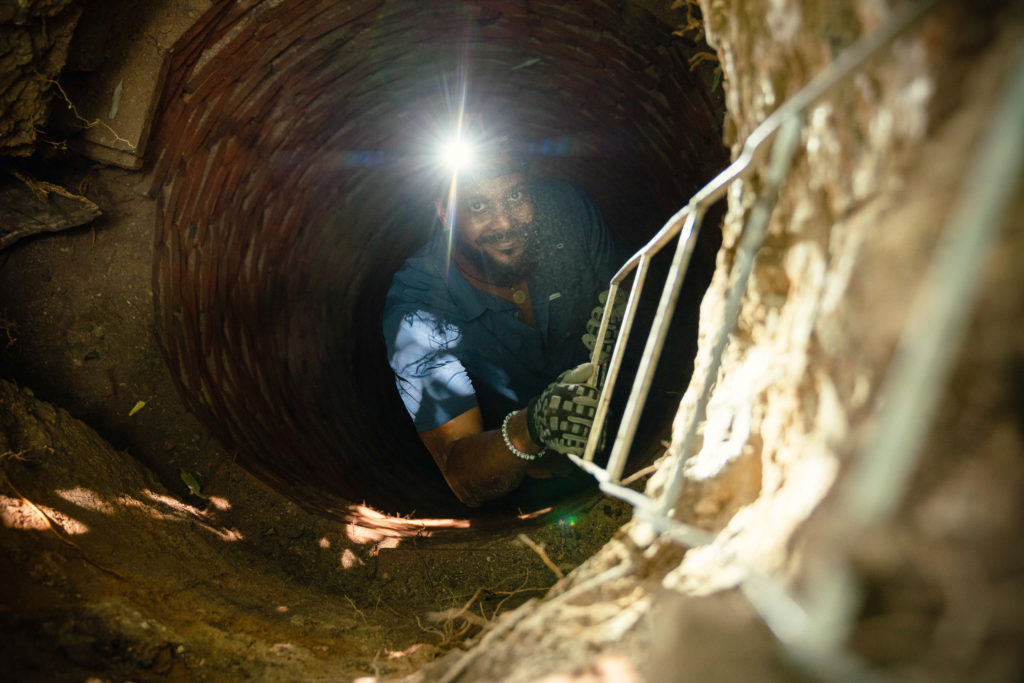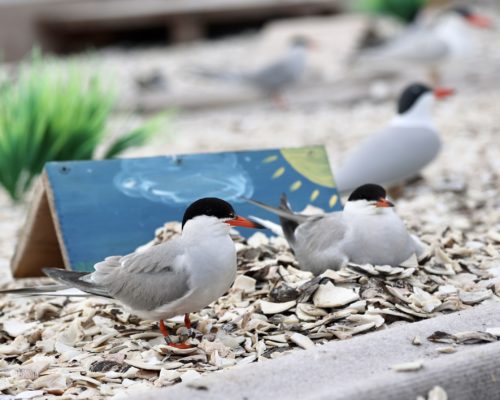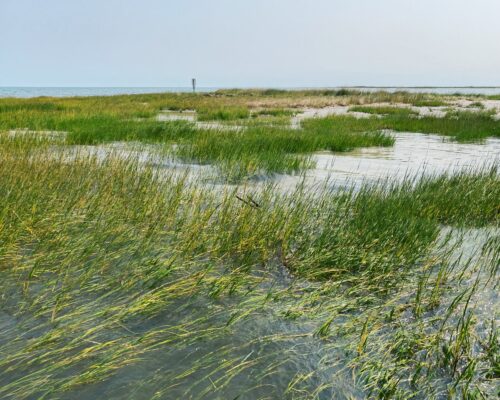Bog. Pissoir. Honeyhole. Dunny. Outhouse. Necessary. There are lots of old terms for what I’m standing in on a beautiful fall Friday in Baltimore, but the most direct way of describing it is a privy—an earthen hole, sometimes lined with cement or barrels, that historically functioned as a rustic outdoor toilet. It’s smelly in here, surprising given that this particular privy was sealed up close to 100 years ago. Replaced by flushing toilets after the Great Fire of Baltimore in 1904 spurred the creation of city public works including running water and sewers, Baltimore was once home to hundreds of thousands of privy vaults like this one.
Privies serviced the residents of working-class rowhomes and fine Mount Vernon townhomes alike. Capped by enclosed wooden structures with a one- or two-hole seat, privies were used to discard deposits of the digestive sort along with all sorts of household goods. Broken crockery, food bones and scraps, liquor bottles, empty medicine vials, and much more were dropped into privy holes, creating time-capsule layers of trash and waste. Enclosed and untouched for sometimes more than a hundred years, Baltimore’s privy vaults hold endless stories about daily life for the average Joe—what they ate, how they played, their ailments and cures, secrets and superstitions.
Today’s privy, between Pigtown and Camden Yards, has been opened and the unsavory contents laboriously shoveled out by hand onto a tarp. Watched over by the fascinated homeowner, the shovelfuls of organic material and wet clay are picked over matter-of-factly by Evan Woodard and his crew of artifact hunters. Nobody is squeamish—hardly anyone is even wearing gloves. What’s a little century-old night soil when there’s all sorts of history to uncover? Sifted out are bits of broken whiteware that could only be from dropped chamber pots, glass medicine bottles, and a few bits of dollhouse china. “Kids definitely lived here,” Woodard says. Towards the bottom of the privy, a shooter marble is plucked out of the vault wall, along with a cheap souvenir egg cup painted with a vaguely chinoiserie design—the kind given out for free by a 19th-century Baltimore five and dime.
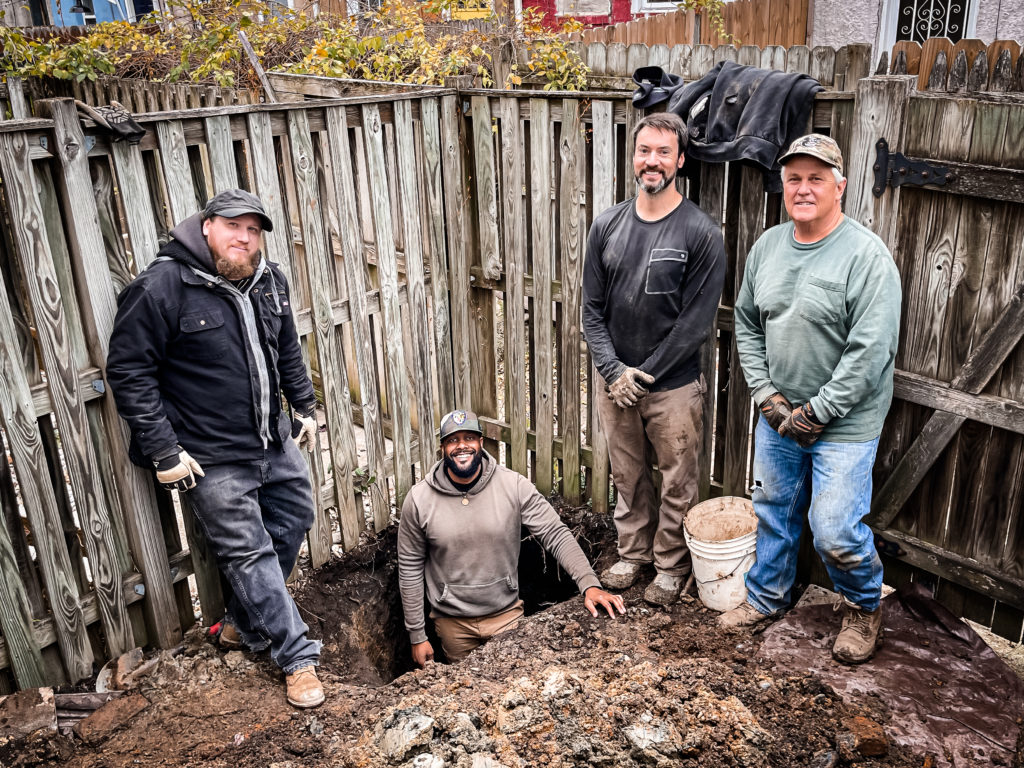
Left to right: Chris Rowell, Evan Woodard, Matt Palmer, Phil Edmonds (Photo courtesy Evan Woodard)
It’s clues like these that motivate Woodard, his friend Matt Palmer, and the rest of the guys onsite. They’re not part of a formal organization, although several “bottle clubs” exist throughout the city and have since the first days of urban renewal in the 1960s. In some cases, they only know each other on a first-name basis. But they are bound together by a passion for the past. With each stoneware fragment or doll’s head they find, these artifact hunters feel time sloughing away, revealing a deeply personal side to a place or inhabitant impossible to find in the written record.
For Woodard and Palmer, longtime friends, privy jumping is just a new extension of their mutual love of urban exploring. Since 2006, when they met on a trip to check out a defunct Pennsylvania coal breaker, they’ve teamed up on all sorts of off-the-books adventures. Whether spelunking down closed coal mines, on forays into the labyrinth of Baltimore’s decrepit sewer system, or risking radiation poisoning at Chernobyl, the two have an insatiable appetite for discovery (and not a small amount of danger). When the pandemic made those types of trips impossible, artifact hunting became a much more feasible way to scratch their itch. “We were walking in the woods on a hike and found some bottles in an old dump,” Woodard says. Woodard kept his find—an old Baltimore beer bottle—and took it home, where he researched the history of the brand. Between the thrill of the hunt and the sense of connecting to a forgotten past, Woodard was hooked.
Since that first find, Woodard has found hundreds more bottles and objects. As a self-described historian, Woodard uses each discovery as a catalyst for research, diving deep into maps and period documents to discover the original use of each object. He takes careful notes of the features he excavates, from the depth to the location via GPS, and donates some of his most notable or rare artifacts to the Baltimore Museum of Industry. Then Woodard shares each object and story on social media. Each of his digs, hikes, discoveries, and research are copiously documented through photos and captions on his Instagram account, SalvageArc. From the size and engagement of his audience (16K and counting just on Instagram), it’s clear Woodard has tapped into growing public fascination with history, artifacts, and adventuring.
Nationally, Woodard is part of a growing trend of layman artifact hunters. From metal detectorists to amateur underwater treasure hunters, the hobby of artifacting has swelled—especially throughout the pandemic when free time was abundant and outdoor pursuits reigned supreme. (Minelab, a metal detector company, sold 18 percent more detectors in 2019 and 30 percent more in 2020.) Many of them can relate to the feeling that motivates Woodard: the sense that history is everywhere if you just know where to look. “There’s a story in every backyard in Baltimore,” Woodard says. “Who lived at the house, what they did for a living, clues to what they ate. History can be accessible to everyone.”
Not everyone is thrilled with that accessibility, or the swelling numbers of DIY privy jumpers, battlefield detectorists, or would-be Indiana Jones treasure hunters. For trained archaeologists, conflicts with artifact hunters are more than headaches—they challenge the fundamental ethics and scientific approach of archaeology. Although what artifact hunters do on private property isn’t illegal, for archeologists it breaks the commandments of the discipline. Part of the taboo is about process: the careful unearthing of the historic record, layer by layer, with copious documentation of each object found through photos, samples, measurements, and notes. This information is used to create a data point in the historic record, painstakingly preserved for posterity. Artifact hunters may be careless or even damaging in their search, destroying the layers of a site or failing to record critical parts of its context so its secrets can never be uncovered.
The other taboo relates to commercialization and looting. Some artifact hunters will sell or trade what they find, from bullets discovered at Gettysburg to reliefs chiseled out of a Mayan frieze. Not all discoveries are museum-worthy sarcophagi, but without the proper research and provenance, it’s hard to know the true value or origins of a discovered object. One man’s old privy trash, in this case, could easily be an actual treasure.
The gulf between these two worlds—the artifact hunter and the archaeologist, the amateur and the academic—can seem impossible to bridge. But people like Dr. David Gadsby, a member of the board of the Council for Maryland Archaeology, are giving it a shot. Gadsby is a proponent of the school of public or community archaeology, a relatively new approach to the discipline developed in the 1970s. That can mean public funding, community participation, or in the case of Gadsby’s work in Hampden in the 2000s, allowing the public to develop the fundamental questions guiding a dig itself. By “pulling back the curtain” on the stories told through archeology and removing barriers to access, Gadsby and archeologists like him hope to channel the public’s desire for historic discovery in ways that enrich the outcomes for all.
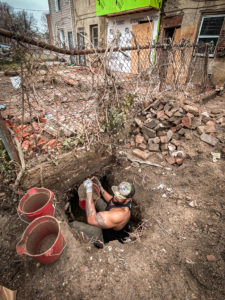
Dr. Gadsby’s Hampden Community Archaeology Project (HCAP) took place in the former 19th-century mill town of Hampden, an historically working class community that’s started to gentrify in recent years. Through public workshops and dialogues, Gadsby and his colleagues were able to use oral history to gather critical information about the neighborhood’s economic past, former inhabitants, and textile work. They also involved the public in the design of the dig’s research and excavation process, even putting students to work onsite. It was a messier and less straightforward approach, Gadbsy admits. Public enthusiasm waned over time, and it was tough to connect with people who were interested in helping out but were working full-time. Ultimately, though, building the public into the fabric of the project itself made the work so much more rewarding. “It’s imperative to do community engagement, to give something back,” Gadsby says. “You owe something to the people in a place to share the history with them.”
For Gadsby, public archeology projects like HCAP can help create a middle ground for people interested in digging into the history in their own backyard. “For folks who are interested in doing archeological work, there are lots of options, whether you’re a kid, a student, or an adult,” Gadsby said. “Rather than grabbing a shovel or a metal detector, find someone who knows what they’re doing and go work with them. And as an archaeologist, it’s important for us to find a way to engage the public as the carrot, rather than only offering the stick.”
Gadsby rattles off a list of archeological organizations, nationally and locally, offering public training, participation, and outreach: American Veterans Archaeological Recovery, the Archaeological Society of Maryland, Maryland Historic Trust, the Herring Run Archaeology Project. Just last winter, Morgan State University and Archaeology in the Community led a public archaeology dig in Druid Heights focused on African American history, excavating row-house privies not too far from the one Woodard dug in Pigtown this fall.
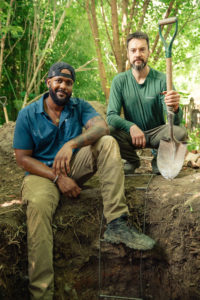
For his part, Woodard is reaching out from the artifact hunting side, too. He’s held workshops on locating sites and determining dig legality for the Enoch Pratt Free Library and taught University of Maryland students how to excavate privies. Woodard’s not against working with a local archaeology group to build his knowledge base and skills more, either. He’s had a few groups reach out to him already, and he’s interested.
Back in Pigtown, the homeowner, Tracy Dimond, drops a little personal time capsule (a racing medal) into the excavated privy hole. Woodard and his team carefully shovel the last bits of material back into the vault and cover the soil with mulch. The bits of crockery, old blue bottles, and porcelain objects the team unearthed are now Tracy’s property, and she is thrilled to have clues to her home’s former inhabitants. Capped and raked, the little rowhouse yard seems undisturbed by artifact hunters or controversy, ready to keep its secrets for another century.

